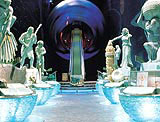Making the old look new
British museums need to be more interactive and entertaining to appeal to a wider market.

Poor old Marks & Spencer. Not only has the retailer failed to stem the tide of decline, but it has now been used as a benchmark for failing to modernise, by the recently appointed Museums, Libraries and Archives Commission chairman Matthew Evans.
Emphasising the need for museums to “fundamentally change what we do and the way we do it”, Evans says: “We risk turning into a cultural version of Marks & Spencer – symbols of once great institutions that have failed to move with the times and are now suffering as a result.”
Evans acknowledges the museum sector’s strengths, such as the “range and diversity of our collections”, but hastens to add: “In order to secure our relevance in the 21st century, we need to break free from the idea that museums are constrained by physical walls.”
Other plans in the MLAC chairman’s blueprint include making museums more socially inclusive, improving standards, embracing new technology and promoting physical and virtual access.
The Science Museum head of design Tim Molloy accepts Evans’ comments, but claims that the issues raised are already being addressed throughout the sector.
“All the things he’s saying we have been responding to for several years. At the Science Museum there has been a very determined effort to improve access over the past decade,” claims Molloy.
Significant additions have been made to the venue since the mid-1990s when The Basement – an exhibit dedicated to making the museum accessible to young people – opened in 1995.
“Every new gallery has a rich mixture of collections and interactions,” says Molloy. “This is the secret to an accessible gallery. The Wellcome Wing is our largest project to date and is intended to relaunch the Science Museum with a new attitude to visitors.
“It will be more responsive to science-related news stories and will encourage a dialogue between the visitor and the exhibition. We want to banish the idea of a passive experience.”
The Internet is beginning to play a pivotal role for museums. Most have websites and some are redeveloping sites in line with physical changes to the venues.
“We really are embracing the electronic medium and exploiting the Net to promote the museum before people arrive and extend activities afterwards. There is a new site and gallery opening in June designed by Johnson Banks, Agency.com and Graphic Thought Facility,” explains Molloy.
Like the Science Museum, the Natural History Museum experienced a growth in visitors during 1998-1999, attracting 1.85m people – its highest figures ever.
Much of its success is due to the opening, in July 1996, of the Earth Galleries, designed by Neal Potter Design Associates, David Bentheim, Wrestless Surface, Event Communications, Exhibition Plus, Land Design Studios and Rawls & Co, among others.
“We have a lively programme of temporary exhibitions, such as Voyages of Discovery last year, combined with permanent fixtures. The Earth Galleries have also been very successful,” says a museum spokeswoman.
Two museums to have experienced stagnancy over the past year are the London Transport Museum and the National Army Museum. Both have started to see physical and virtual changes to their make-up in recent months.
London Transport Museum spokesman Ken Kelling believes all museums now have “two key issues” to address.
“Interaction and people’s expectations are different today and all museums are competing for people’s leisure time. Basically, it’s about making your collection accessible,” he explains. “We think of ourselves as a 21st century museum and are putting the exhibition on the Internet. It’s not just about physical visits to the museum, but about access through the Web, too.”
The Covent Garden-based museum launched a website in May 1999, designed in-house. It is updated weekly. There is also a former depot site in Acton, which opened in October, created by Paul Mullins Associates (DW 7 May 1999).
“The website expands the museum worldwide and means more people can access information without coming to the museum,” says Kelling.
A National Army Museum spokesman echoes Kelling’s sentiments, but maintains that visitors still want the physical experience of going to a museum.
Funded by the Ministry of Defence, the museum has been the victim of funding cuts, though it still attracted nearly 125,000 people last year.
National Army Museum spokesman Julian Humphrys says the venue is listening to public opinion about what is exhibited. “We are working with the modern army and doing news-related exhibitions now, about Kosovo and the Falklands,” he explains.
“We’ve had a website since 1997 and get interest from all round the world. We are starting to put on many aspects of the collection too, but people want to actually see the things and get the scale of them. The Internet is an important way of getting information to visitors, but it’s only part of the course. There’s still the need to visit.”
London design group Shelton Fleming created the Art of Harley Davidson exhibition at the Barbican Art Gallery last year, and is developing the Art of Star Wars exhibition, which opens at the same venue in April.
The consultancy’s managing director Maurice Fleming claims “flexibility” is vital to the success of museums in the future. “Immense investment is put into permanent exhibitions, but they eventually become tired, the local audience figures drop and then it’s thrown away,” he says.
“They need to be taken to a broader audience. When you conceive the dinosaur skeleton you can do it with nuts and bolts instead of welding it. It means the exhibit can then tour easily and the museum stays fresh too. Sophistication can be combined into a flexible solution,” Fleming maintains.
Evans admits that “museums are at a crossroads,” but he is still optimistic about the what the future holds. “If we take the right path, the rewards of success will be very great indeed.”
-
Post a comment




